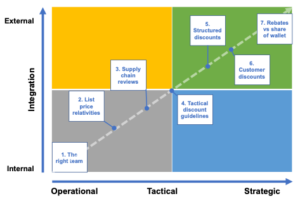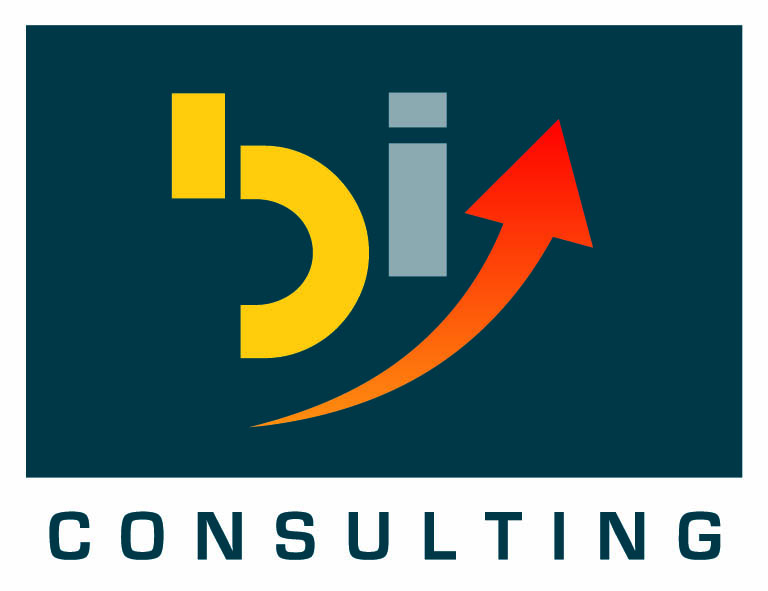
Good to great in seven steps
As pricing and margin improvement advisors and consultants, we often get asked how to move pricing activities from good to great. The obvious question to start with is ‘What does great look like?’ Of course, the standard consultant’s answer of ‘it depends’ applies. We find that most organisations are able to move to a level far ahead of what they expected possible by consistently following a structured approach and continually iterating and updating tools, processes and people skills. By this I mean that what looks great today, might look commonplace in one or two years time.
Whatever your approach, there are some fundamental steps we recommend to take you on the path to greatness. Some fairly obvious and some not so. For me, the real key is ensuring that the other parts of the business integrate with the pricing activities … or should that be the pricing activities integrate with the other activities … no, wait … just make sure business activities are joined up. It’s not one group’s responsibility to connect with others, it’s everyone’s responsibility to work as part of a business-wide team, not just a functional team.
When starting out on the path to greatness, in pricing at least, there are a number of operational, tactical and strategic aspects that have to be considered from both an internal and external perspective.
Before an organisation begins its price improvement journey, it is essential to ensure that there is a defined pricing strategy in place. What does your business want to achieve for your brands and products in each of your active customer and distributor segments? You would be surprised at the number of companies I speak to who cannot clearly and simply explain their pricing strategy.
The operational
The obvious place to start is with people and tools. Most organisations that we speak with already have a pricing manager, some even have a pricing team. The key question is, are they decision makers or analysts? Are they analysing transactions and pointing out missed opportunities or are they taking the lead and recommending what price should be charged, to which customers at which time? This is often defined by leadership within the business. If pricing is seen as a supporting function, then it will be simply that. If it is seen as a key activity, then it will report directly to the board and have the appropriate priority and strategic importance.
One of the first key decisions this team has to make is to define what the price positioning should be for your brands and sub-brands compared to competitors and peers. From this, a clear set of prices with agreed relativities can be set and clear price lists reflecting the agreed positioning and relativities of all products can be created. Clearly this cannot be done in isolation and needs the input of marketing, sales, finance, manufacturing and supply chain. As I mentioned earlier, an integrated approach is needed. To avoid logjam at this point, clear business processes along with roles, responsibilities and accountability for pricing should also be defined.
In terms of tooling, most pricing teams rely heavily on the existing reporting and analysis tools and many, many spreadsheets to conduct analysis, create possible scenarios and share information. This represents challenges in terms of version control, managing approvals, meeting audit requirements and then implementing the newly agreed price in the accounting and invoicing system. While reporting tools and spreadsheets are a good place to start, as the processes and the practice of pricing matures within a business, more sophisticated tooling is required. Big data / AI led analysis and recommendation generation is becoming more common and much more necessary to handle the growing mass of data that our businesses generate every trading day.

The tactical
In B2B, a key issue that gets little attention is cost to serve. We often see small, low margin generating customers receiving the same customer service, frequency of orders and shipments as large margin generating customers. Reviewing and reducing customer service levels where appropriate is a very effective way of improving margins by removing variable cost instead of increasing prices.
Once we have our strategy, our pricing team and our price points, we now need to enable sales to go and deliver the results. For sales, particularly in B2B, rigid sales structures are too limiting as there is always a final negotiation between buyer and seller. Here, pre-determined tactical discount guidelines should be used based on the agreed approach per segment / customer type / volume purchased. This allows sales the flexibility they need, while still providing a degree of structure to discounts and therefore margins.
The strategic
A further step that I recommend is to develop structured discounts such as order quantity breaks, full truck loads or full pallet loads, for example, to allow the customer to extract more value whilst lowering your cost of doing business. This helps both of you and if considered carefully will enable greater efficiency in the supply chain and encourage an even closer customer / supplier partnership.
Once you have your pricing approach defined and you begin to generate information on the effectiveness of the steps taken so far, the customer discounts should be reviewed and refined. This should be done based on segmentation using customer behaviours to identify value vs pure spend metrics. As an ongoing practice, spend by segment should be regularly reviewed and challenged to ensure the right segments get the correct amount of focus.
The last and perhaps most misunderstood and misused tool in the sales and pricing managers’ toolkit is rebates. So often rebate targets are set adding a % to last year’s total sales. In my experience, rebates set in this way become expected and do not drive loyalty or a change in buying behaviour. Here there is an opportunity to set more strategic targets such as driving share of wallet or improving the product mix by setting sales targets built up at sub-category or category level.
Ideally, the tactical discounts, structured discounts and rebates should be considered and implemented as part of a wider account management programme. Not only will this provide consistency, it will provide transparency for all accounts and empower sales to better manage customer expectations.
